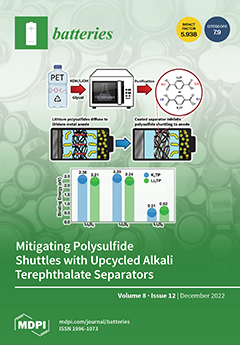Rechargeable aqueous Zn/MnO
2 batteries are very potential for large-scale energy storage applications owing to their low cost, inherent safety, and high theoretical capacity. However, the MnO
2 cathode delivers unsatisfactory cycling performance owing to its low intrinsic electronic conductivity and dissolution issue.
[...] Read more.
Rechargeable aqueous Zn/MnO
2 batteries are very potential for large-scale energy storage applications owing to their low cost, inherent safety, and high theoretical capacity. However, the MnO
2 cathode delivers unsatisfactory cycling performance owing to its low intrinsic electronic conductivity and dissolution issue. Herein, we design and synthesize a Ag-doped sea-urchin-like MnO
2 material for rechargeable zinc-ion batteries (ZIBs). Doping Ag was found to reduce charge transfer resistance, increase the redox activity, and improve the cycling stability of MnO
2. The unique sea-urchin-like structure maintains rich active sites for charge storage. As a result, the Ag-doped MnO
2-based ZIB presents a high reversible specific capacity to 315 mA h g
−1 at 50 mA g
−1, excellent rate performance, and a capacity retention of 94.4% when cycling over 500 cycles. An ex situ TEM test demonstrates the low-dissolution property of Ag-doped MnO
2. A flexible quasi-solid-state ZIB is successfully assembled using Ag-doped MnO
2 on graphite paper, which shows a stable specific capacity of 171 mA h g
−1 at 1 A g
−1 when cycled over 600 cycles. Our investigation demonstrates the significant role played by Ag doping in enhancing the ZIB performance of MnO
2, and gives some insight into developing advanced active materials by heteroatom doping.
Full article





